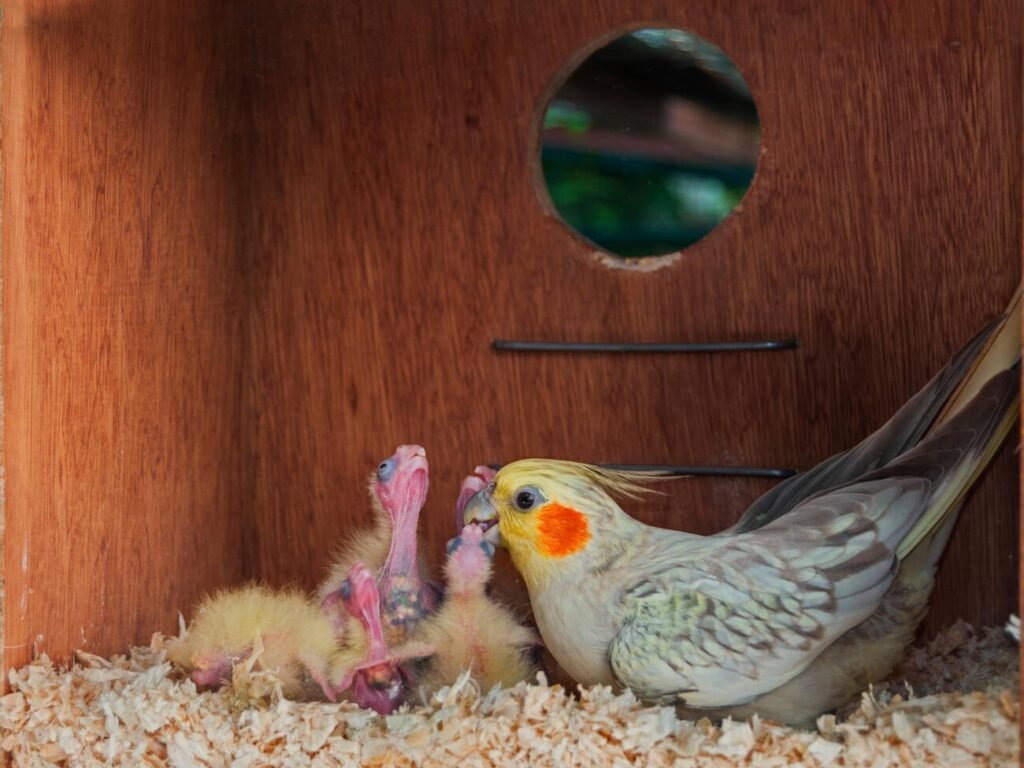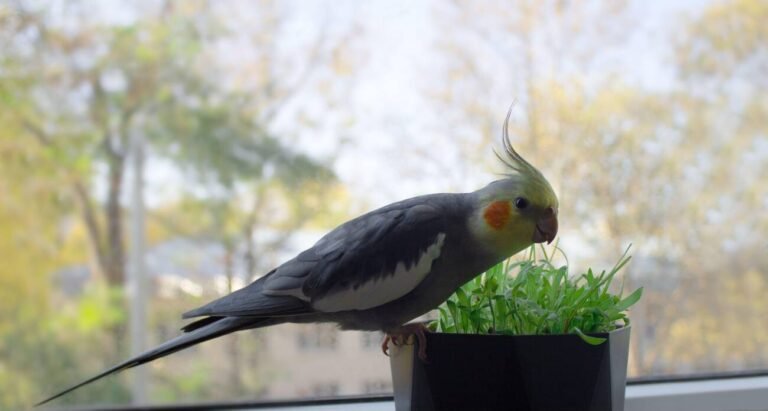Cockatiel Breeding Box Setup and Size Details

I have been breeding cockatiels for over a decade and have experience with various cockatiel variants. I understand what it takes to breed them successfully. A crucial part of my breeding process involves using a well-designed breeding box setup. Creating an ideal breeding environment for cockatiels requires careful consideration of several factors, including the dimensions and size of the breeding box, the materials used in its construction, and its placement within the aviary or cage.
In this comprehensive guide, we will explore each aspect in detail to ensure the comfort, safety, and well-being of both the breeding pair and their offspring.
Introduction to Cockatiel Breeding
Cockatiels, native to Australia, are social birds that thrive in pairs. Breeding them requires understanding their natural behaviors, including nesting, caring for young, and social interactions. When in captivity, it’s essential to provide a conducive environment to encourage these natural behaviors.
Why Breeding Boxes Matter
The breeding box is not just a space for laying eggs; it is a critical environment where the birds feel safe and comfortable. A well-constructed breeding box can significantly influence the success of the breeding process, affecting everything from egg laying to chick rearing.
Dimensions and Size Requirements of the Breeding Box
Providing adequate space is essential for the comfort and safety of the birds. Let’s explore the recommended dimensions in more detail:
Height
- Recommendation: 12 to 15 inches (30 to 38 cm)
- Importance: A taller box allows the cockatiels to perch comfortably. This vertical space mimics their natural nesting habits in trees, providing them with room to move and engage in natural behaviors like preening and stretching.
Width
- Recommendation: 12 to 14 inches (30 to 36 cm)
- Importance: Sufficient width is necessary for the breeding pair to sit side by side. This closeness fosters bonding and allows both parents to share in the care of their chicks.
Depth
- Recommendation: Approximately 12 inches (30 cm)
- Importance: A deeper box provides ample space for nesting materials, which are essential for insulation and comfort. It also gives chicks enough room to grow without feeling cramped, promoting healthy development.
Entrance Hole
- Recommendation: 3 to 4 inches (7.5 to 10 cm) in diameter
- Importance: The entrance hole should be large enough for easy access but small enough to deter predators. This design choice protects the birds while allowing the parents to enter and exit without difficulty.
Summary Table of Dimensions
| Dimension | Size (inches) | Size (cm) |
|---|---|---|
| Height | 12-15 | 30-38 |
| Width | 12-14 | 30-36 |
| Depth | 12 | 30 |
| Entrance Hole | 3-4 | 7.5-10 |
Materials Used in Constructing the Breeding Box
Choosing the right materials is vital for creating a safe, durable, and comfortable breeding box. Let’s delve into the key materials:
Wood
- Recommendation: Untreated, non-toxic hardwoods such as oak or cedar.
- Importance: Treated wood can contain harmful chemicals that may be toxic to birds. Hardwoods are preferred for their durability and resistance to wear, ensuring the breeding box lasts through multiple breeding cycles. Additionally, the natural aroma of cedar can help deter pests.
Interior Coating
- Recommendation: Nesting materials like pine shavings or shredded paper.
- Importance: These materials provide insulation and comfort. They help maintain a stable temperature inside the box and offer a soft environment for the chicks to rest on. Regularly changing these materials also promotes hygiene, reducing the risk of disease.
Roof
- Recommendation: A secure, hinged roof.
- Importance: The roof protects against rain and drafts, essential for maintaining a stable environment. A hinged design allows easy access for cleaning and monitoring, making it more convenient for caretakers to ensure the well-being of the birds.
Summary Table of Materials
| Material | Description |
|---|---|
| Untreated Wood | Non-toxic, durable (e.g., oak, cedar) |
| Nesting Material | Pine shavings or shredded paper for comfort |
| Hinged Roof | Allows easy access while protecting against elements |
Placement of the Breeding Box
Placement plays a significant role in the success of breeding. Here are detailed considerations:
Height
- Recommendation: 4 to 6 feet (1.2 to 1.8 meters) above ground.
- Importance: Placing the box at this height simulates the natural nesting environments of cockatiels, which often choose elevated sites. This height also reduces the risk of predation from ground animals.
Orientation
- Recommendation: Entrance hole facing away from direct sunlight and prevailing winds.
- Importance: Positioning the box away from harsh weather conditions provides a sheltered environment, helping regulate temperature and humidity levels inside the box, crucial for incubating eggs.
Privacy
- Recommendation: A quiet, secluded area in the aviary or cage.
- Importance: Reducing disturbances is vital for the nesting pair, as stress can lead to abandonment of eggs or chicks. Privacy allows the birds to engage in natural behaviors without fear of being observed or disturbed.
Accessibility
- Recommendation: Easily reachable for monitoring and cleaning.
- Importance: While privacy is essential, ensuring that the box is accessible allows caretakers to perform regular checks on the birds’ health and hygiene without causing stress.
Summary Table of Placement Factors
| Placement Factor | Recommendation |
|---|---|
| Height | 4-6 feet (1.2-1.8 meters) above ground |
| Orientation | Away from direct sunlight and strong winds |
| Privacy | Quiet and secluded area |
| Accessibility | Easily reachable for monitoring/cleaning |
Additional Considerations for Breeding Cockatiels
Beyond the breeding box setup, several other factors contribute to a successful breeding environment:
1. Monitoring
- Importance: Regularly observing the nesting pair and their chicks allows you to identify any potential health issues or behavioral problems early. Look for signs of distress, changes in feeding habits, or any neglect of eggs or chicks. Early intervention can make a significant difference in outcomes.
2. Cleaning
- Importance: Maintaining a clean breeding box is essential to prevent the buildup of waste, which can harbor parasites and diseases. Cleaning should include replacing soiled nesting materials and disinfecting surfaces with bird-safe cleaners. A clean environment promotes the overall health of the birds and their young.
3. Safety
- Importance: Regularly check the breeding box for any potential hazards, such as sharp edges or loose fittings that could harm the birds. Inspect the integrity of the entrance hole to ensure it remains predator-proof. Safety checks should be a routine part of your breeding management.
4. Nutrition
- Importance: A well-balanced diet is crucial for the health of the breeding pair. High-quality pellets, seeds, and fresh produce should make up their diet. Calcium is particularly important during the breeding season, so providing cuttlebone and mineral blocks can support the health of the eggs and chicks.
Summary Table of Additional Considerations
| Consideration | Details |
|---|---|
| Monitoring | Regular checks for health and behavior |
| Cleaning | Frequent cleaning to prevent waste buildup |
| Safety | Inspect for hazards and ensure predator-proofing |
| Nutrition | Balanced diet rich in essential nutrients |
Conclusion
Creating an ideal breeding environment for cockatiels involves meticulous planning and attention to detail. By focusing on the breeding box’s dimensions, materials, placement, and overall care considerations, you can foster a safe and comfortable space for the breeding pair and their chicks.
Final Tips
- Research: Stay updated on the latest breeding practices and recommendations. Join forums or groups where experienced breeders share insights and tips.
- Patience: Understand that breeding can be unpredictable, and not all pairs will breed successfully on their first attempt. Patience is key.
- Community: Engage with other breeders to exchange experiences and learn from one another. Shared knowledge can be invaluable in refining your breeding practices.
By fostering a well-thought-out breeding environment, you can enjoy the beauty of cockatiel chicks while promoting their health and happiness. With dedication and care, breeding cockatiels can be a fulfilling and enriching experience. Happy breeding!



